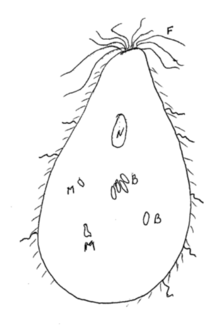Mixotricha paradoxa
| Mixotricha paradoxa | |
|---|---|
 | |
| Scientific classification | |
| Domain: | Eukaryota |
| (unranked): | Excavata |
| Phylum: | Metamonada |
| Class: | Parabasalia |
| Order: | Trichomonadida |
| Family: | Devescovinidae |
| Genus: | Mixotricha |
| Species: | M. paradoxa |
| Binomial name | |
| Mixotricha paradoxa Sutherland, 1933 | |
Mixotricha paradoxa is a species of protozoan that lives inside the gut of the Australian termite species Mastotermes darwiniensis[1] and has multiple bacterial symbionts.[2] The name, given by the Australian biologist J.L. Sutherland, who first described Mixotricha in 1933,[3][4] means “the paradoxical being with mixed-up hairs”.
Symbiosis
Mixotricha forms many symbiotic relationships. Like its relatives, including Trichonympha, it lives in the gut of termites and helps them digest cellulose, a major component of the wood they eat. Without Mixotricha, its host termites could not survive.
Mixotricha forms mutualistic relationships with bacteria living inside the termite as well. There are a total of four species of bacterial symbionts. While Mixotricha has four anterior flagella, it does not use them for locomotion, but more for steering. For locomotion, about 250,000 hairlike Treponema spirochetes, a species of helical bacteria, are attached to the cell surface and provide the cell with cilia-like movements. Mixotricha also has rod-shaped bacteria arranged in an ordered pattern on the surface of the cell; both of these types are ectosymbionts. In addition it has spherical bacteria inside the cell; these endosymbionts function as mitochondria, which Mixotricha lacks. Mixotricha lost their mitochondria but retain both organelles and nuclear genes derived from them. Mitochondrial relics include hydrogenosomes which produce hydrogen and small structures called mitosomes.[5]
Genome
According to Margulis and Sagan (2001), Mixotricha have five genomes, as they form very close symbiotic relationships with four types of bacteria.[6] They consider Mixotricha paradoxa the poster organism for symbiogenesis. Hunt et al. (2001, 2002) also consider it a composite organism with five genomes.
References
- ↑ Radek R, Nitsch G (November 2007). "Ectobiotic spirochetes of flagellates from the termite Mastotermes darwiniensis: attachment and cyst formation". Eur. J. Protistol. 43 (4): 281–94. doi:10.1016/j.ejop.2007.06.004. PMID 17764914.
- ↑ Brugerolle G (October 2004). "Devescovinid features, a remarkable surface cytoskeleton, and epibiotic bacteria revisited in Mixotricha paradoxa, a parabasalid flagellate". Protoplasma. 224 (1–2): 49–59. doi:10.1007/s00709-004-0052-8. PMID 15726809.
- ↑ Jean L. Sutherland: Protozoa from Australian Termites. Quarterly Journal of Microscopical Science, Band s2-76, S. 145-173. (Abstract)
- ↑ L. R. Cleveland, A. V. Grimstone: The Fine Structure of the Flagellate Mixotricha paradoxa and Its Associated Micro-Organisms. Proceedings of the Royal Society of London. Series B, Biological Sciences, Band 159, 1964, S. 668-686. doi:10.1098/rspb.1964.0025
- ↑ tutorgig.net
- ↑ Margulis, Lynn; Sagan, Dorion (June 2001). "The Beast with Five Genomes". Natural History. Archived from the original on 2006-11-15. Retrieved 2007-05-03.